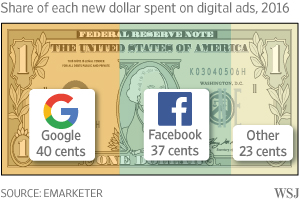 As we’ve noted before, there’s a gap in the publishing industry that appears to be widening. On the one side, we have the stats on print ad revenue that continues to show declines in the market overall. On the other side, we hear plenty of stories about publishers seeing the ad sales pendulum swing back, and finding success with paid content strategies.
As we’ve noted before, there’s a gap in the publishing industry that appears to be widening. On the one side, we have the stats on print ad revenue that continues to show declines in the market overall. On the other side, we hear plenty of stories about publishers seeing the ad sales pendulum swing back, and finding success with paid content strategies.
For many of these publishers, a key component of their paid content model is less reliance on the behemoth of third-party platforms and unlocking the potential of their own first-hand data.
“While Facebook and Google have amplified their commitment to subscriptions through products, publishers are wary of how close they want to get with them,” writes Lucinda Southern in Digiday. “Platforms widen the acquisition funnel, but who owns the data is a key concern, as well as how successfully customers acquired through social side doors will retain.”
The New York Times, for example, understanding their audience is so critical they remodeled their entire data structure.
“The New York Times has a centralized data team of 78 people; two years ago, the data teams for content, advertising and subscriptions were siloed across the organization,” Southern writes. “In order to scale the subscription business, the Times needed a central pillar for its data efforts.”
That data now provides the insights they need to understand their reader behavior and adapt accordingly, something that’s impossible to do if your user data is held by a third-party platform.
“How frequently someone returns to the Times is an important signal in determining whether they will subscribe, so getting people back through tactics like newsletters is a key way of converting them,” Southern explains after talking with the Times’ SVP for data insights Laura Evans. “In terms of retention models, the changes in how people are behaving send warning flags they could churn, for instance, someone who goes form reading eight to five articles a day is at a higher risk than someone reading once a week.”
You can’t get this kind of insights from third-party platforms. We’ve been saying for years that this kind of distribution is too much of a crapshoot; the dramatic drop in referral traffic helped spark a wave of publishers ditching the platform in favor of other traffic driving techniques.
That’s not to say it’s entirely useless as a tactic; some publishers do indeed reach new audiences on Facebook and Google. But it’s not the end-all, and shouldn’t be seen as such.
“You can’t be a publisher and not be thinking about platforms, not marry with them. Facebook needs to be a marketing tentacle,” said Jed Williams, chief innovation officer of trade association Local Media Association. “All its products are used to deepen the one-to-one relationship.”
The key to making a paid model work is, of course, relevant high-quality content, so your readers will see the value and pay accordingly.
“The duopoly are middlemen. [Blockchain-based platform] Civil makes the relationship between the reader and publisher easier,” said Nushin Rashidian, co-founder of Cannabis Wire, which will soon start charging $1 a day to access a daily newsletter about the business implications on legalizing cannabis.
“Readers are owners of the system too, so it’s a co-op model. If we publish nonsense, the readers will kick us out.”
For publishers looking to monetize their readers, they can’t get this wrong. Your audience is your first priority, and understanding this is where you cross the gap into profitability and sustainability.

August 14, 2020, 3:52 am
October 7, 2020, 4:17 pm
October 8, 2020, 3:52 am